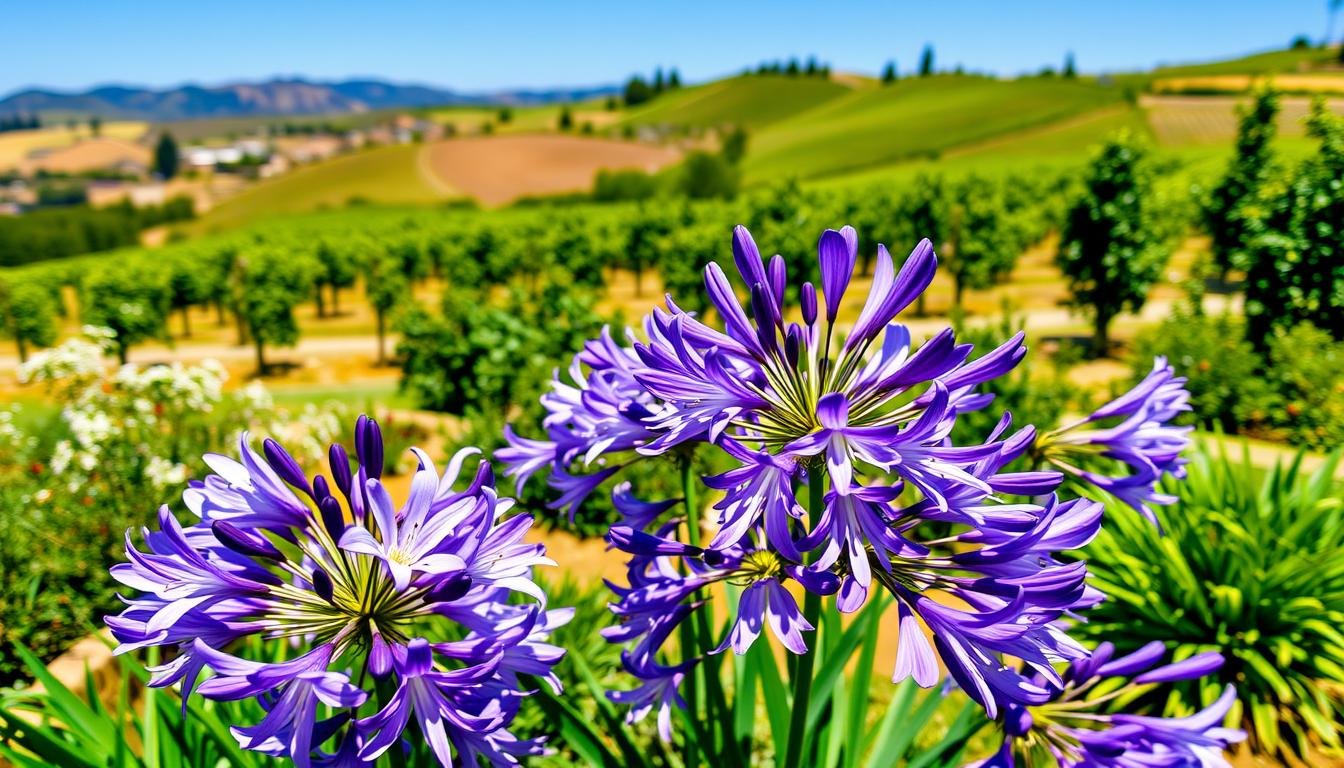Standing in my garden in Temecula, I feel excitement every season. Seeing my plants wake up is a sign of life’s strength. The Agapanthus, or Lily of the Nile, is a favorite of mine. It’s beautiful and easy to care for.
In southern California’s warm climate, I wonder: Do Agapanthus Do Well in Temecula CA? This question is important for gardeners wanting vibrant, easy gardens. I’m eager to share what I’ve learned about growing these stunning flowers.
Temecula has special soil, climate, and care needs for Agapanthus. Knowing how to grow them well is important for anyone wanting a beautiful garden. In this article, I’ll talk about Agapanthus, how they adapt to our area, and the best ways to grow them. If you’re curious about growing Agapanthus, I’m here to help!
Key Takeaways
- Agapanthus thrives in USDA Zones 8-11, making Temecula’s Zone 9 ideal.
- It prefers well-drained soil with a slightly acidic to neutral pH for optimal growth.
- Regular irrigation is essential to maintain healthy Agapanthus plants in the dry summers.
- Applying slow-release fertilizer in spring supports growth and flowering.
- Agapanthus blooms late summer to early fall, adding vibrant color to any garden.
- Utilizing drip irrigation can help retain soil moisture during dry spells.
- For more information on plant care, I recommend checking out this guide on Agapanthus care in Temecula.
Table of Contents
Introduction to Agapanthus
Agapanthus, also called the African Lily, is a beautiful perennial plant. It has stunning clusters of flowers in blue and white. It comes from South Africa and loves warm weather, making it great for southern California gardens.
This plant is not just pretty. It’s also easy to care for, perfect for those who don’t want to spend a lot of time gardening. Whether you’re new to gardening or have been doing it for years, learning about agapanthus care can make your garden come alive.
Adding Agapanthus to your garden makes it look better and adds elegance. Its lush leaves and bright flowers have a big impact. This makes it a favorite among garden lovers.
Characteristics of Agapanthus
Agapanthus is a beautiful plant that’s great for gardens. It has amazing qualities that make any garden look better. Its unique blooming and growth make it perfect for easy garden care.
Flowering and Foliage
Agapanthus flowers in bright blues or whites in globe-like clusters. These blooms show up from late summer to early fall. They add color when other plants stop blooming.
Its leaves stay green all year. This makes it interesting to look at even in winter.
Growth Habit and Size
Agapanthus comes in different sizes. For example, the Storm Cloud Agapanthus grows up to 15 inches tall. It blooms up to 4 feet high.
This plant grows upright, which is good for borders or as a focal point. It spreads about 3 feet wide, making a beautiful display.
Agapanthus grows at a medium pace. It’s easy to care for once it’s settled. It does well in full sun to partial shade and can handle city pollution.
Climatic Suitability of Temecula
Knowing the weather in Temecula is key for growing plants like Agapanthus. This area has a mediterranean climate. It has hot, dry summers and mild, wet winters. This climate is perfect for Agapanthus to grow well, if they get what they need.
Mediterranean Climate Overview
The temecula climate has long, sunny days in summer. This helps plants grow strong. Agapanthus likes warm weather and well-draining soil to grow well.
Temperature and Weather Patterns
In Temecula, most rain falls in winter. Summer needs careful watering. Keeping plants watered helps them avoid heat stress.
| Season | Average Temperature (°F) | Average Rainfall (inches) |
|---|---|---|
| Winter | 45-65 | 3-5 |
| Spring | 55-75 | 1-3 |
| Summer | 70-95 | 0-1 |
| Fall | 55-80 | 1-3 |
do agapanthus do well in temecula ca

Agapanthus does great in Temecula, CA. It loves the warm weather of southern California. This makes it a favorite for gardens.
But, to make them grow well, you need to take good care. Planting and caring for them right can help a lot.
Adaptability to Local Climate
Agapanthus is very adaptable. It does well in southern California’s mild winters and hot summers. This makes it perfect for many places, like gardens and pots.
Protecting them from too much heat is also important. Knowing the weather helps them grow well, which is why many people choose them.
Importance of Soil Quality
Soil quality is key for agapanthus. They need soil that drains well. Sometimes, you might need to add things to the soil to make it better.
A slightly acidic to neutral soil pH is best. Adding organic matter helps the soil drain better and gives nutrients. This is important for agapanthus.
| Agapanthus Variety | Average Height | Average Width | Flower Color | Bloom Time | Lifespan |
|---|---|---|---|---|---|
| Blue African Agapanthus | 12-30 inches | 18 inches | Sky Blue | Late Summer to Early Fall | 10 years |
| Baby Pete™ Agapanthus | 24 inches | 18 inches | Sky Blue | Mid-Spring to Summer | 10 years |
| Peter Pan Agapanthus | 12-18 inches | 18 inches | Sky Blue | Mid-Spring to Summer | 10 years |
Soil and Planting Conditions for Agapanthus
To grow agapanthus well, you need the right soil and preparation. I found that good soil helps plants grow strong and bloom brightly. The soil type is key for plant health and flowers.
Soil Type and Preparation
Agapanthus loves soil that drains well. I added compost or manure to improve drainage and give nutrients. This makes a great base for the plants to grow.
Adding organic matter makes the soil better for roots. It helps plants get established.
pH Levels and Drainage Considerations
Testing your soil is important to know its pH. Agapanthus likes a pH between 6.0 and 7.0. If it’s off, you can use lime or sulfur to fix it.
Drainage is also key. I added sand or perlite to help water drain. Here are some tips for better drainage:
- Choose a spot that drains well.
- Use raised beds for better water flow.
- Add perlite to the soil when preparing it.
| Property | Details |
|---|---|
| Soil Type | Well-drained, rich in organic matter |
| Recommended pH | 6.0 to 7.0 |
| Drainage Tips | Raised beds, amendment with perlite |
| Organic Amendments | Compost, well-rotted manure |
By using these soil tips and checking pH levels, your agapanthus will thrive. I’ve seen how important these details are for a beautiful garden.
Caring for Agapanthus in Temecula

Caring for Agapanthus in Temecula needs focus on key practices. I’ve learned that right care makes these flowers bloom well in our climate. Watering, fertilizing, and pruning are key to their health.
Watering Guidelines
Watering Agapanthus regularly is crucial, especially in Temecula’s dry summers. Water deeply, letting the top inch of soil dry before watering again. This stops root rot from too much water. Mulching helps keep moisture in and keeps plants healthy.
Fertilizing Tips
Spring is the best time to fertilize Agapanthus with a balanced, slow-release fertilizer. This helps them grow strong and bloom well. But, don’t over-fertilize, as it can harm blooms. Knowing how to water and fertilize makes plants bloom better.
Pruning and Maintenance Practices
Pruning Agapanthus regularly makes them look better and grow more. Deadheading spent flowers and removing yellow leaves helps. Pruning in early spring gets plants ready for growth and fights pests.
| Practice | Recommendation | Description |
|---|---|---|
| Watering | Maximize Depth | Water deeply, allowing the top layer to dry before re-watering to prevent rot. |
| Fertilizing | Spring Application | Use balanced, slow-release fertilizer to promote blooms without excessive foliage. |
| Pruning | Early Spring Tasks | Remove spent flowers and yellow leaves; prepares plant for new growth and reduces pests. |
Advantages of Growing Agapanthus in Southern California
Growing Agapanthus in Southern California has many benefits. It’s perfect for gardens that don’t need much water. These flowers are easy to care for, making gardening simple.
Drought Tolerance and Low Maintenance
Agapanthus loves dry weather, which is great for Southern California. It needs very little water once it’s settled. This saves water and time on gardening.
It’s perfect for both new and experienced gardeners. Agapanthus makes gardening easy with low-maintenance landscaping.
Attracting Pollinators to Your Garden
Agapanthus is also great for attracting bees and butterflies. Its bright flowers add beauty to the garden. They also help pollinators, making the garden healthier.
In short, Agapanthus is a great choice for Southern California gardens. It’s good for the environment and easy to care for. Adding Agapanthus makes gardens more beautiful and diverse.
Challenges to Consider When Cultivating Agapanthus
Agapanthus can do well in Temecula’s warm weather. But, there are challenges to overcome for a great garden. Heat stress is a big problem. Too much heat without enough water can cause plants to wilt and grow poorly.
Also, soil drainage is key. Bad drainage can lead to root rot. This shows how important it is to solve drainage issues to keep plants healthy.
Heat Stress and Soil Drainage Issues
Not enough water can make heat stress worse. It’s important to check the soil moisture often. This helps prevent damage from heat.
Also, keeping the soil drained well helps avoid root rot. Choosing the right spot for planting is essential. It should have good drainage and the right soil.
Pests and Diseases
Pests like aphids and snails can harm Agapanthus. They can stop plants from growing and flowering. Using natural pest control and keeping the garden clean helps a lot.
Also, watching for diseases is important. Regular checks help keep Agapanthus healthy and looking good.
For more tips on keeping plants healthy, visit Bee Green Garden.




